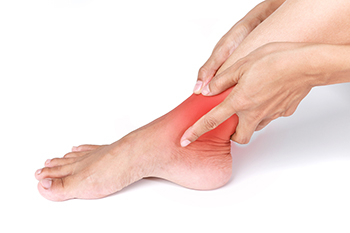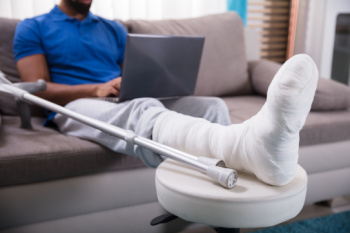November 2024

Chronic ankle pain and instability often result from repeated ankle injuries, creating a cycle of pain, weakness, and a fear of reinjury. Those affected may experience a sensation of the ankle giving way, soreness, and swelling that make daily activities challenging. This condition frequently affects athletes or active individuals who have had multiple sprains, weakening the ligaments, and leaving the joint unstable. It can also affect older people more. Causes include ligament damage, insufficient healing, or scar tissue buildup, and it is more common in those with high-impact lifestyles or a history of untreated ankle injuries. Without proper care, chronic ankle instability can lead to cartilage damage and arthritis over time. Treatment may include targeted exercise and bracing. In persistent cases, surgery might be considered. If you have chronic ankle pain and instability, it is strongly suggested that you visit a podiatrist who can help develop a personalized treatment plan to restore stability and reduce the risk of future injuries.
Ankle pain can have many different causes and the pain may potentially be serious. If you have ankle pain, consult with one of our podiatrists from Comprehensive Foot & Ankle Center of South Jersey. Our doctors will assess your condition and provide you with quality foot and ankle treatment.
Ankle pain is any condition that causes pain in the ankle. Due to the fact that the ankle consists of tendons, muscles, bones, and ligaments, ankle pain can come from a number of different conditions.
Causes
The most common causes of ankle pain include:
- Types of arthritis (rheumatoid, osteoarthritis, and gout)
- Ankle sprains
- Broken ankles
- Achilles tendinitis
- Achilles tendon rupture
- Stress fractures
- Tarsal tunnel syndrome
- Plantar fasciitis
Symptoms
Symptoms of ankle injury vary based upon the condition. Pain may include general pain and discomfort, swelling, aching, redness, bruising, burning or stabbing sensations, and/or loss of sensation.
Diagnosis
Due to the wide variety of potential causes of ankle pain, podiatrists will utilize a number of different methods to properly diagnose ankle pain. This can include asking for personal and family medical histories and of any recent injuries. Further diagnosis may include sensation tests, a physical examination, and potentially x-rays or other imaging tests.
Treatment
Just as the range of causes varies widely, so do treatments. Some more common treatments are rest, ice packs, keeping pressure off the foot, orthotics and braces, medication for inflammation and pain, and surgery.
If you have any questions, please feel free to contact our offices located in Cherry Hill, Voorhees, Atco, and Turnersville, NJ . We offer the newest diagnostic and treatment technologies for all your foot care needs.

An avulsion fracture in the foot occurs when a small bone fragment is pulled away by a tendon or ligament attached to it, often resulting from a sudden twist or impact. This type of fracture is common in sports or activities involving rapid direction changes. Unlike other fractures, which may break across the bone or completely separate it, an avulsion fracture only affects the area where the ligament or tendon attaches, often leaving the main bone intact. Symptoms include pain, swelling, and difficulty bearing weight. Seeing a podiatrist is essential for proper diagnosis and treatment. They will likely use imaging tests to assess the injury, and may recommend treatments like rest, immobilization, or targeted exercises to aid in recovery. In more severe cases, surgical intervention may be necessary to reattach the fragment. If you have broken your foot, it is suggested that you visit a podiatrist to determine the type of fracture sustained, and receive appropriate treatment.
A broken foot requires immediate medical attention and treatment. If you need your feet checked, contact one of our podiatrists from Comprehensive Foot & Ankle Center of South Jersey. Our doctors can provide the care you need to keep you pain-free and on your feet.
Broken Foot Causes, Symptoms, and Treatment
A broken foot is caused by one of the bones in the foot typically breaking when bended, crushed, or stretched beyond its natural capabilities. Usually the location of the fracture indicates how the break occurred, whether it was through an object, fall, or any other type of injury.
Common Symptoms of Broken Feet:
- Bruising
- Pain
- Redness
- Swelling
- Blue in color
- Numbness
- Cold
- Misshapen
- Cuts
- Deformities
Those that suspect they have a broken foot shoot seek urgent medical attention where a medical professional could diagnose the severity.
Treatment for broken bones varies depending on the cause, severity and location. Some will require the use of splints, casts or crutches while others could even involve surgery to repair the broken bones. Personal care includes the use of ice and keeping the foot stabilized and elevated.
If you have any questions please feel free to contact our offices located in Cherry Hill, Voorhees, Atco, and Turnersville, NJ . We offer the newest diagnostic and treatment technologies for all your foot and ankle needs.

Minimally invasive surgical techniques have become valuable in podiatric surgery, offering effective solutions for common foot and ankle conditions with less trauma than traditional methods. These procedures involve small incisions, often under five millimeters, and specialized instruments to address issues like bunions, hammertoes, and bone spurs. By minimizing soft tissue disruption, minimally invasive surgery reduces postoperative pain, swelling, and the need for extensive recovery time, allowing patients to return to daily activities sooner. These techniques are particularly beneficial for patients with underlying health conditions who may not be ideal candidates for open surgery. Using real-time imaging, podiatrists can accurately correct deformities and other structural issues with high precision. Additionally, the reduced risk of infection and scarring makes these procedures attractive for both patients and practitioners. If you are facing the possibility of foot surgery, it is suggested that you consult a podiatrist to see if you are a candidate for this type of surgery.
Foot surgery is sometimes necessary to treat a foot ailment. To learn more, contact one of our podiatrists of Comprehensive Foot & Ankle Center of South Jersey. Our doctors will assist you with all of your foot and ankle needs.
When Is Surgery Necessary?
Foot and ankle surgery is generally reserved for cases in which less invasive, conservative procedures have failed to alleviate the problem. Some of the cases in which surgery may be necessary include:
- Removing foot deformities like bunions and bone spurs
- Severe arthritis that has caused bone issues
- Cosmetic reconstruction
What Types of Surgery Are There?
The type of surgery you receive will depend on the nature of the problem you have. Some of the possible surgeries include:
- Bunionectomy for painful bunions
- Surgical fusion for realignment of bones
- Neuropathy decompression surgery to treat nerve damage
Benefits of Surgery
Although surgery is usually a last resort, it can provide more complete pain relief compared to non-surgical methods and may allow you to finally resume full activity.
Surgical techniques have also become increasingly sophisticated. Techniques like endoscopic surgery allow for smaller incisions and faster recovery times.
If you have any questions please feel free to contact our offices located in Cherry Hill, Voorhees, Atco, and Turnersville, NJ . We offer the newest diagnostic and treatment technologies for all your foot and ankle needs.

Foot pain can signal various underlying conditions, some of which should not be ignored due to their potential severity. Gout, caused by a buildup of uric acid crystals in the joints, leads to sudden, intense pain, especially in the big toe, and requires medical treatment to prevent damage. Diabetic foot pain often results from neuropathy, which can reduce sensation and lead to serious complications like ulcers or infections. Psoriatic arthritis may cause joint pain and swelling in the toes, needing ongoing management. Heel pain, often linked to plantar fasciitis, may worsen without proper care. Stress fractures, small cracks in the bone caused by overuse, can develop into more serious injuries if untreated. Lastly, foot pain caused by a blood clot, especially with accompanying redness, swelling, or warmth, requires immediate medical attention, as it could indicate deep vein thrombosis, a life-threatening condition. If you have persistent or worsening foot pain, it is suggested that you schedule an appointment with a podiatrist for a proper diagnosis and appropriate treatment.
Foot Pain
Foot pain can be extremely painful and debilitating. If you have a foot pain, consult with one of our podiatrists from Comprehensive Foot & Ankle Center of South Jersey. Our doctors will assess your condition and provide you with quality foot and ankle treatment.
Causes
Foot pain is a very broad condition that could be caused by one or more ailments. The most common include:
- Bunions
- Hammertoes
- Plantar Fasciitis
- Bone Spurs
- Corns
- Tarsal Tunnel Syndrome
- Ingrown Toenails
- Arthritis (such as Gout, Rheumatoid, and Osteoarthritis)
- Flat Feet
- Injury (from stress fractures, broken toe, foot, ankle, Achilles tendon ruptures, and sprains)
- And more
Diagnosis
To figure out the cause of foot pain, podiatrists utilize several different methods. This can range from simple visual inspections and sensation tests to X-rays and MRI scans. Prior medical history, family medical history, and any recent physical traumatic events will all be taken into consideration for a proper diagnosis.
Treatment
Treatment depends upon the cause of the foot pain. Whether it is resting, staying off the foot, or having surgery; podiatrists have a number of treatment options available for foot pain.
If you have any questions, please feel free to contact our offices located in Cherry Hill, Voorhees, Atco, and Turnersville, NJ . We offer the newest diagnostic and treatment technologies for all your foot care needs.

